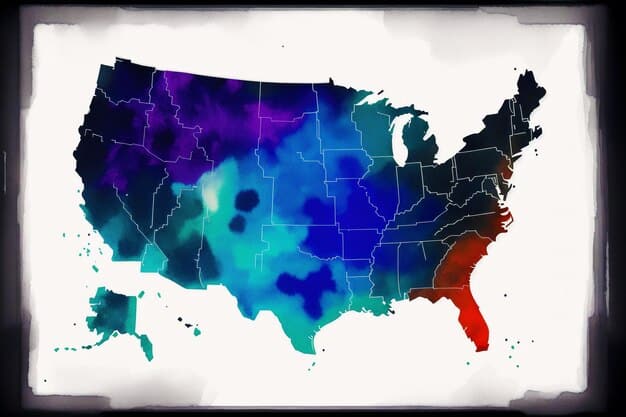US Gun Control Policy: Latest Legislation Impacts on Owners & Safety

The evolving landscape of US Gun Control Policy involves complex legislative changes, significantly impacting both gun owners’ rights and public safety measures, reflecting the ongoing societal debate between Second Amendment protections and crime reduction efforts.
The debate surrounding US Gun Control Policy is one of the most enduring and complex in American society, deeply affecting both the discourse on individual liberties and the critical issue of public safety. Understanding the latest legislative developments is crucial for every citizen, from committed gun owners to those advocating for stricter regulations, as these policies continuously reshape the legal framework surrounding firearm ownership and use.
Understanding the Historical Context of US Gun Control
The history of gun control in the United States is as old as the nation itself, rooted in the Second Amendment’s declaration about the right to keep and bear arms. This foundational right has been interpreted and reinterpreted over centuries, leading to a patchwork of federal, state, and local laws that vary significantly across jurisdictions. Early regulations were often local, focusing on preventing gun violence in specific areas.
The 20th century saw the introduction of federal legislation, largely in response to organized crime and rising concerns about public safety. Landmark laws like the National Firearms Act of 1934 and the Gun Control Act of 1968 marked significant shifts, imposing stricter regulations on certain types of firearms and establishing federal licensing requirements for gun dealers. These acts laid the groundwork for future policies, often sparking intense legal and political battles. The core tension remains between constitutional rights and the collective good.
Key Milestones in Federal Gun Legislation
Early 20th-century laws primarily targeted specific dangerous weapons and individuals.
- National Firearms Act (NFA) of 1934: Imposed taxes and registration requirements on machine guns, sawed-off shotguns, and other destructive devices.
- Gun Control Act (GCA) of 1968: Broadened federal regulations, prohibiting convicted felons and others from purchasing firearms, and regulating interstate firearm commerce.
- Brady Handgun Violence Prevention Act of 1993: Mandated federal background checks for firearm purchases from licensed dealers.
As the nation evolved, so did the nature of firearms and the incidents involving them, prompting continuous legislative discussions. The debate often centers on what constitutes a “well-regulated Militia” and how that right translates to individual gun ownership in modern society. This historical backdrop is essential for comprehending the current state of gun control.
Recent Federal Legislative Developments and Their Impact
In recent years, the United States has witnessed renewed efforts at the federal level to address gun violence, particularly following high-profile mass shootings. These legislative pushes represent attempts to find common ground in a deeply divided political landscape, seeking to enhance public safety while respecting constitutional rights. The bipartisan Safer Communities Act, signed into law in 2022, stands out as a significant piece of federal legislation.
This act, while not as expansive as some advocates desired, implemented several new provisions aimed at reducing gun violence. It represents the most substantial federal gun safety legislation in nearly 30 years and signals a potential shift in congressional willingness to pass gun control measures. The law’s provisions focus on areas that traditionally garner more bipartisan support, such as mental health services and enhanced background checks for younger buyers.
Provisions of the Bipartisan Safer Communities Act (2022)
The 2022 act introduced several key changes designed to enhance gun safety.
- Enhanced Background Checks for Under-21 Buyers: For buyers under 21, the law allows for an enhanced review period, giving authorities more time to check juvenile and mental health records.
- Funding for State Red Flag Laws: Provides federal funding for states to implement and administer “red flag” laws, which permit temporary removal of firearms from individuals deemed a danger to themselves or others.
- Increased Investment in Mental Health Services: Allocates significant funding to expand access to mental health services for young people and families.
- Closer Look at Illegal Firearm Trafficking: Closes the “boyfriend loophole” by expanding prohibitions on domestic violence offenders from purchasing firearms.
While limited in scope compared to some proposals, the act demonstrates a federal commitment to addressing gun violence through a multi-faceted approach. Its impact will likely be seen over time as states implement its provisions and as federal agencies enforce the new regulations. Gun owners must stay informed about how these changes might affect their ability to purchase and possess firearms.
State-Level Gun Control: A Patchwork of Regulations
The American approach to gun control is characterized by its highly decentralized nature, with states retaining significant authority to legislate on firearms. This results in a complex and often contradictory patchwork of laws across the country. What is legal in one state might be strictly prohibited in an adjacent one, creating challenges for gun owners, law enforcement, and policymakers alike.
States frequently implement policies that go beyond federal minimums, particularly concerning firearm sales, types of weapons allowed, and concealed carry permits. For instance, some states have universal background checks, requiring checks for all firearm sales, including those between private citizens, while others do not. Similarly, “assault weapon” bans and high-capacity magazine prohibitions are common in some states but absent in others. This variability is a direct reflection of varying political climates and public opinions on gun control across different regions.

Divergent State Approaches to Firearm Regulation
State laws often reflect local values and priorities regarding Second Amendment rights versus public safety.
- Universal Background Checks: States like California and New York require background checks for all gun sales, including private transactions, which is stricter than federal law.
- “Assault Weapon” Bans and Magazine Capacity Limits: States such as Maryland and Connecticut have banned certain types of firearms classified as “assault weapons” and limit magazine capacities.
- Concealed and Open Carry Laws: Laws regarding the carrying of firearms in public vary wildly, from “permitless carry” states to those requiring extensive training and permits.
These state-level differences mean that understanding your rights and responsibilities as a gun owner is highly dependent on your geographic location. The existence of these diverse laws also fuels legal challenges, with courts constantly asked to rule on the constitutionality of various state regulations.
What New Legislation Means for Gun Owners
The evolving landscape of gun control legislation has direct and substantial implications for gun owners across the United States. New laws, whether federal or state-level, can introduce new requirements, restrictions, or, in some cases, expand rights. Understanding these changes is paramount for legal compliance and responsible firearm ownership. The enforcement of new regulations often requires gun owners to adapt to new purchasing procedures, storage requirements, or even relinquish certain types of firearms, depending on the specifics of the law.
For instance, enhanced background checks or new waiting periods can alter the process of acquiring a firearm. Similarly, bans on specific weapon types or accessories might necessitate changes in an owner’s arsenal. Additionally, “red flag” laws, though controversial, introduce a mechanism by which firearms can be temporarily removed from an individual deemed a risk, impacting due process considerations for some gun owners. It is important for gun owners to proactively seek out reliable information regarding new legislation in their jurisdiction.
The shift in legislative focus, particularly towards mental health and domestic violence, also means that circumstances beyond the firearm itself can affect ownership rights. Maintaining awareness of these nuanced changes is crucial for exercising gun rights responsibly and legally.
Public Safety Implications of Legislative Changes
The primary stated goal of most gun control legislation is to enhance public safety by reducing gun violence. Proponents argue that stricter laws can decrease homicides, suicides, and accidental shootings. The impact of new legislation on public safety is a complex issue, often debated with mixed results and varying interpretations of data. Policies such as enhanced background checks are intended to keep firearms out of the hands of prohibited individuals, thereby reducing crime.
Red flag laws aim to prevent violence by allowing authorities to intervene before an individual causes harm. Investments in mental health services, as included in the Bipartisan Safer Communities Act, are also seen as a public safety measure, addressing underlying issues that may contribute to violence. However, assessing the direct causal link between specific legislative changes and a measurable reduction in gun violence is challenging due to numerous confounding factors, including socio-economic conditions, law enforcement practices, and cultural norms.
Even so, policymakers and public health experts look to these legislative changes as critical components of a broader strategy to mitigate the devastating effects of gun violence. The ongoing assessment of these laws’ effectiveness contributes to the continuous debate over efficacy and necessity.
Measuring the Efficacy of Gun Control Measures
Evaluating the real-world impact of gun control laws involves complex statistical analysis and long-term studies.
- Background Checks: Proponents cite studies suggesting universal background checks can reduce firearm homicides.
- “Red Flag” Laws: Data indicates these laws may prevent suicides and mass shootings, though their implementation varies.
- Mental Health Interventions: Investing in mental health infrastructure aims to address root causes of violence, potentially reducing gun-related incidents.
Ongoing research and data collection are vital to understand whether these legislative efforts translate into a safer environment for communities. The long-term effects of these policies will continue to be a subject of academic study and public discourse.
The Ongoing Debate: Rights, Safety, and the Judiciary
The debate over gun control in the United States transcends mere policy preferences; it is deeply rooted in constitutional interpretation, deeply held beliefs about individual liberty, and pressing concerns about public safety. At the heart of this tension is the Second Amendment, whose meaning has been continuously contested and shaped by judicial rulings. Landmark Supreme Court cases like District of Columbia v. Heller (2008) and McDonald v. City of Chicago (2010) affirmed an individual’s right to possess a firearm for self-defense, while also acknowledging the government’s power to regulate gun ownership.
More recently, New York State Rifle & Pistol Association Inc. v. Bruen (2022) further impacted gun laws by striking down a New York law
that required an applicant for a concealed-carry permit to show “proper cause,” effectively expanding gun ownership rights outside the home. This ruling has far-reaching implications, challenging the constitutionality of various existing and future state-level gun control measures. The judiciary plays a critical role in defining the boundaries of gun rights and the scope of permissible regulation.
As new legislation is introduced, it is almost invariably met with legal challenges, forcing courts to balance competing interests. This continuous legal battle means that the future of gun control in the US remains fluid and dependent not only on legislative action but also on judicial interpretation.
Future Directions and Judicial Scrutiny
The path forward for gun control policy will heavily rely on how courts interpret constitutional rights.
- Challenges to Existing and New Laws: Many new state-level gun laws are immediately challenged in court, sometimes leading to injunctions.
- Impact of Bruen Decision: The Bruen ruling is being used to challenge a wide array of gun restrictions across the country, from assault weapon bans to age restrictions.
- The Role of the Supreme Court: Future Supreme Court decisions will continue to shape the legal landscape of gun control for decades to come.
This dynamic interplay between the legislative and judicial branches ensures that the debate over gun rights and public safety will remain a central feature of American civic life. Citizens, advocacy groups, and policymakers will all continue to play a role in shaping its direction.
| Key Aspect | Brief Description |
|---|---|
| 📜 Historical Context | US gun control laws have evolved from local ordinances to federal acts, shaping the Second Amendment’s interpretation over centuries. |
| ⚖️ Federal Legislation | Recent federal laws, like the Bipartisan Safer Communities Act, focus on enhanced background checks and mental health funding. |
| 🗺️ State Variations | Gun laws vary significantly across states, creating a complex legal patchwork for owners and law enforcement. |
| 🛡️ Public Safety Bid | Legislation aims to reduce gun violence through various measures, though direct impacts are often debated and constantly studied. |
Frequently Asked Questions About US Gun Control Policy
The Bipartisan Safer Communities Act is the most significant federal gun safety legislation passed in nearly 30 years. Enacted in 2022, it enhances background checks for gun buyers under 21, provides funding for state red flag laws, and invests heavily in mental health services, aiming to reduce gun violence while reflecting a bipartisan compromise on a contentious issue.
Federal gun laws set national minimum standards for firearm regulations, such as the prohibition of certain individuals from owning guns or requirements for licensed dealers. State laws often build upon or exceed these federal standards, implementing additional restrictions on firearm types, sales, and carrying permits, leading to significant variations across the United States. This creates a complex regulatory environment.
“Red flag” laws, also known as extreme risk protection orders, allow courts to temporarily remove firearms from individuals deemed a danger to themselves or others. Typically, family members or law enforcement can petition a court, which then holds a hearing to determine if there is sufficient evidence to issue an order. These laws vary by state but aim to prevent potential gun violence.
The Supreme Court’s decision in New York State Rifle & Pistol Association Inc. v. Bruen (2022) significantly affected gun control by ruling that a New York law requiring “proper cause” to carry a handgun in public was unconstitutional. This decision expanded gun rights by establishing a “text, history, and tradition” test for firearm regulations, potentially challenging many existing state gun control laws across the US.
Gun owners must remain informed about both federal and state legislative changes, as these can impact firearm purchasing processes, possession rights, storage requirements, and carrying permits. Regularly checking official government sources, reputable legal analyses, and gun owner advocacy groups for updates in their specific jurisdiction is crucial for maintaining legal compliance and responsible firearm ownership.
Conclusion
The landscape of US Gun Control Policy remains a dynamic and intensely debated area, continuously shaped by a complex interplay of historical interpretation, legislative action, and judicial review. From the foundational principles embedded in the Second Amendment to the nuances of recent federal and state laws, understanding these policies is essential for both gun owners and those committed to public safety. As the nation grapples with varying perspectives on rights and risks, the evolution of gun control will undoubtedly continue to be a central focus of American policy and discourse.





